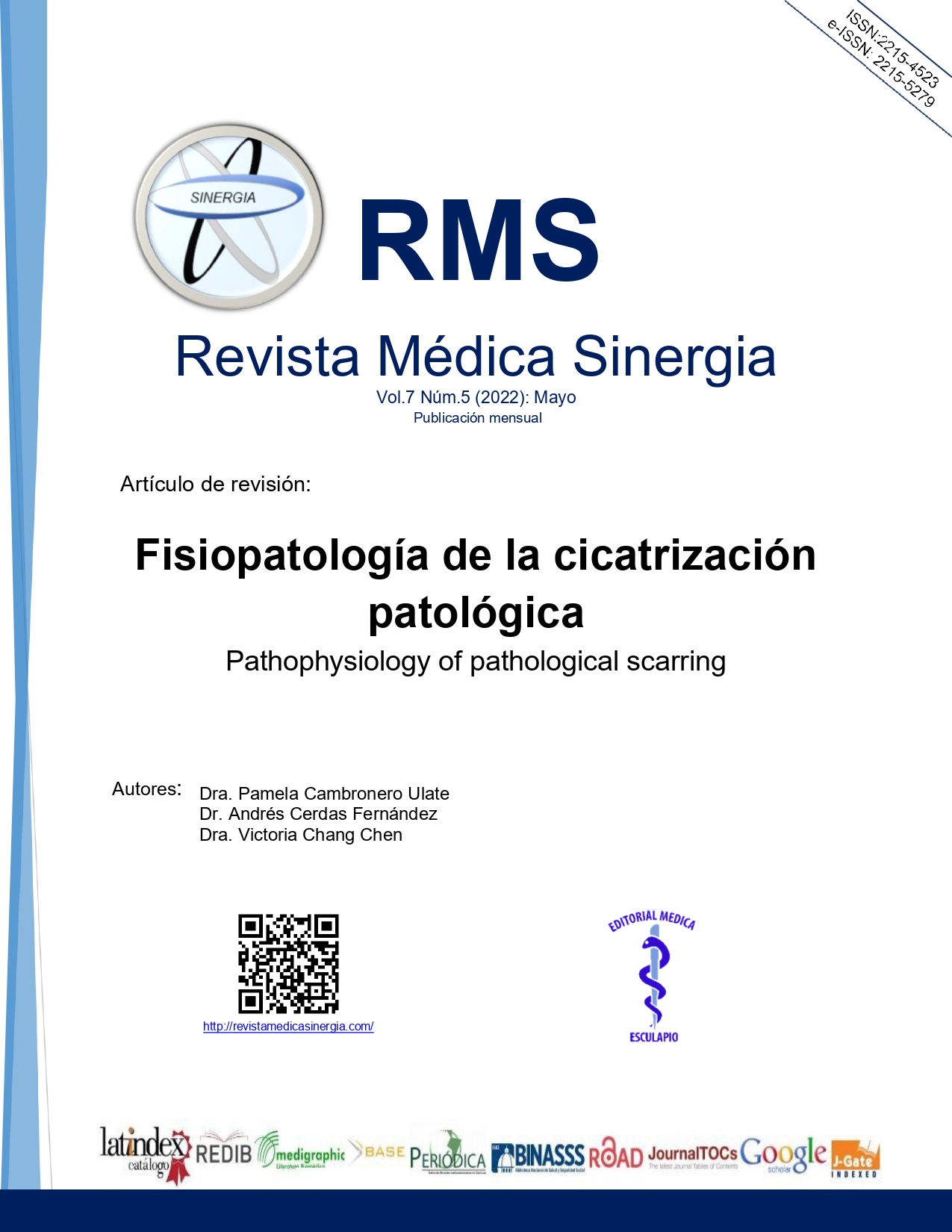Abstract
Wound healing is a process by which the skin regenerates after it suffers a traumatic event. Normal healing is divided into 3 phases: homeostasis-inflammation, deterioration, and maturation-remodeling. Different biological and molecular processes perfectly adapted to the formation of a scar are involved in these phases. In turn, if any of these is altered, pathological scars arise. Pathological scars include keloids and hypertrophic scars. These are fibrotic lesions, which are clinically characterized as erythematous, painful, and pruritic. The pathogenesis of these two forms of scarring is not completely understood, however, it is known that there is an imbalance between the catabolic and anabolic phases. Its formation will depend on systemic factors, genetic factors, and local mechanical stress. In addition, among the systemic factors that influence the appearance of pathological scarring are angiogenic balance factors, inflammatory/immunological factors, and endocrinological factors. As can be seen, it is not a single factor that defines the formation of keloids or pathological scars, but rather a set of determinants that causes their formation
Keywords
References
Wang P, Huang B, Horng H, Yeh C, Chen Y. Wound healing. Journal of the Chinese Medical
Association. 2018;81(2):94-101. https://doi.org/10.1016/j.jcma.2017.11.002
Huang C, Ogawa R. Systemic factors that shape cutaneous pathological scarring. The FASEB Journal. 2020;34(10):13171-13184. https://doi.org/10.1096/fj.202001157R
Huang C, Liu L, You Z, Zhao Y, Dong J, Du Y, et al. Endothelial dysfunction and mechanobiology in pathological cutaneous scarring: lessons learned from soft tissue fibrosis. British Journal of Dermatology. 2017;177(5):1248-1255. https://doi.org/10.1111/bjd.15576
Ogawa R. Keloid and Hypertrophic Scars Are the Result of Chronic Inflammation in the Reticular Dermis. International Journal of Molecular Sciences. 2017;18(3):606. https://doi.org/10.3390/ijms18030606
Potter D, Veitch D, Johnston G. Scarring and wound healing. British Journal of Hospital Medicine. 2019;80(11):166-171.
Yuan F, Sun Z, Feng Y, Liu S, Du Y, Yu S et al. Epithelial–mesenchymal transition in the formation of hypertrophic scars and keloids. Journal of Cellular Physiology. 2019;234(12):21662-21669.
Wilkinson H, Hardman M. Wound healing: cellular mechanisms and pathological outcomes. Open Biology. 2020;10(9):200223. https://royalsocietypublishing.org/doi/10.1098/rsob.200223
Barchitta M, Maugeri A, Favara G, Magnano San Lio R, Evola G, Agodi A et al. Nutrition and Wound Healing: An Overview Focusing on the Beneficial Effects of Curcumin. Int J Mol Sci. 2019;20(5):1-3.
Kaplani K, Koutsi S, Armenis V, Skondra F, Karantzelis N, Champeris Tsaniras S, et al. Wound healing related agents: Ongoing research and perspectives. Advanced Drug Delivery Reviews. 2018;129:242-253.
Nourian Dehkordi A, Mirahmadi Babaheydari F, Chehelgerdi M, Raeisi Dehkordi S. Skin tissue engineering: wound healing based on stem-cell-based therapeutic strategies. Stem Cell Research & Therapy. 2019;10(1). https://stemcellres.biomedcentral.com/articles/10.1186/s13287-019-1212-2
Armstrong D, Meyr A. Basic principles of wound healing. In Berman R, Eidt J, Mills J, Collins K, editors. Uptodate. [Internet]. Waltham (MA). UpToDate Inc; 2022 [updated July 02, 2020; cited January 18, 2022].
Janis J, Harrison B. Wound Healing. Plastic and Reconstructive Surgery. 2016;138:9S-17S.
Karppinen S, Heljasvaara R, Gullberg D, Tasanen K, Pihlajaniemi T. Toward understanding scarless skin wound healing and pathological scarring. F1000Research. 2019;8:787.
Flegg J, Menon S, Byrne H, McElwain D. A Current Perspective on Wound Healing and Tumour-Induced Angiogenesis. Bulletin of Mathematical Biology. 2020;82(2). https://www.worldcat.org/title/current-perspective-on-wound-healing-and-tumour-induced-angiogenesis/oclc/1196785217
Goldstein A, Hong A. Keloids and hypertrophic scars. In: Delavalle R, Levy M, Alexis A. Corona R, editors. Uptodate. [Internet]. Waltham (MA). UpToDate Inc; 2022 [updated February 16, 2021; cited January 18, 2022]. Available from: https://www.uptodate.com/contents/keloids-and-hypertrophic-scars

This work is licensed under a Creative Commons Attribution-NonCommercial 4.0 International License.
Copyright (c) 2022 Array


